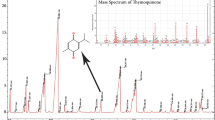Abstract
Cashew nut shell liquid (CSNL) nanoemulsion has been formulated and its cytotoxic activity was determined using human breast cancer cells (MCF-7) adopting MTT assay and established staining techniques. MCF-7 cells treated with CSNL nanoemulsion suffered loss of viability and death mostly through apoptosis and/or necrosis as evidenced by the changes in the nuclear morphology and cytoplasmic features. The IC50 value of 48-h treatment groups fall in the range of 88 ± 14.2 μl/ml. In conclusion, the antiproliferative and morphological effects of CSNL nanoemulsion appear to be target-specific killing of cells which gives further lead to study apoptotic pathways as target for breast cancer therapy. This study has provided a scientific basis for the anti-tumor property of CSNL nanoemulsion with respect to breast cancer.




Similar content being viewed by others
References
Bouchemal KS, Briancon E, Perrier, Fessi H (2004) Nano-emulsion formulation using spontaneous emulsification: solvent, oil and surfactant optimisation. Int J Pharm 280:241–251
Chandregowda V, Kush A, Reddy GC (2009) Synthesis of benzamide derivatives of anacardic acid and their cytotoxic activity. Eur J Med Chem 44(6):2711–2719
De Lima SG, Feitosa CM, Cito AM, Moita Neto JM, Lopes JA, Leite AS, Brito MC, Dantas SM, Cavalcante AA (2008) Effects of immature cashew nut-shell liquid (Anacardium occidentale) against oxidative damage in Saccharomyces cerevisiae and inhibition of acetylcholinesterase activity. Genet Mol Res 7(3):806–818
de Paula AA, Martins JB, dos Santos ML, Nascente Lde C, Romeiro LA, Areas TF, Vieira KS, Gambôa NF, Castro NG, Gargano R (2009) New potential AChE inhibitor candidates. Eur J Med Chem 44(9):3754–3759
George J, Kuttan R (1997) Mutagenic, carcinogenic and cocarcinogenic activity of cashewnut shell liquid. Cancer Lett 112(1):11–16
Gerber B, Scholz C, Reimer T, Briese V, Janni W (2006) Complementary and alternative therapeutic approaches in patients with early breast cancer: a systematic review. Breast Cancer Res Treat 95:199–209
Kamatha V, Rajini PS (2007) The efficacy of cashew nut (Anacardium occidentale L.) skin extract as a free radical scavenger. Food Chem 103:428–433
Morais TC, Pinto NB, Carvalho KM, Rios JB, Ricardo NM, Trevisan MT, Rao VS, Santos FA (2010) Protective effect of anacardic acids from cashew (Anacardium occidentale) on ethanol-induced gastric damage in mice. Chem Biol Interact 183(1):264–269
Mosmann T (1983) Rapid colorimetric assay for cellular growth and survival: application to proliferation and cytotoxicity assays. J Immunol Methods 65:55–63
Parkin DM, Bray F, Ferlay J, Pisani P (2005) Global cancer statistics, 2002. CA Cancer J Clin 55:74
Seki J, Sonoke S, Saheki A, Fukui H, Sasaki H, Mayumi T (2004) A nanometer lipid emulsion, lipid nano-sphere (LNS), as a parenteral drug carrier for passive drug targeting. Int J Pharm 273:75–83
Singh B, Kale RK, Rao AR (2004) Modulation of antioxidant potential in liver of mice by kernel oil of cashew nut (Anacardium occidentale) and its lack of tumour promoting ability in DMBA induced skin papillomagenesis. Indian J Exp Biol 42(4):373–377
Sun Y, Jiang X, Chen S, Price BD (2006) Inhibition of histone acetyltransferase activity by anacardic acid sensitizes tumor cells to ionizing radiation. FEBS Lett 580(18):4353–4356
Sung B, Pandey MK, Ahn KS, Yi T, Chaturvedi MM, Liu M, Aggarwal BB (2008) Anacardic acid (6-nonadecyl salicylic acid), an inhibitor of histone acetyltransferase, suppresses expression of nuclear factor-κB-regulated gene products involved in cell survival, proliferation, invasion, and inflammation through inhibition of the inhibitory subunit of nuclear factor-κBα kinase, leading to potentiation of apoptosis. Blood 111(10):4880–4891
Trevisan MT, Pfundstein B, Haubner R, Wurtele G, Spiegelhalder B, Bartsch H, Owen RW (2006) Characterization of alkyl phenols in cashew (Anacardium occidentale) products and assay of their antioxidant capacity. Food Chem Toxicol 44(2):188–197
Ushanandini S, Nagaraju S, Nayaka SC, Kumar KH, Kemparaju K, Girish KS (2009) The anti-ophidian properties of Anacardium occidentale bark extract. Immunopharmacol Immunotoxicol 31(4):607–615
Acknowledgments
We thank King Saud University, Riyadh, KSA for the cell culture and instrumentation facilities. We acknowledge Nanokaryon Bioproducts and Services, Salem, Tamil Nadu, India for some technical assistance. The authors declare that there is no conflict of interest that would prejudice the impartiality of this scientific work.
Author information
Authors and Affiliations
Corresponding author
Rights and permissions
About this article
Cite this article
Al-Hazzani, A., Periyasamy, V., Subash-Babu, P. et al. Formulation of cashew nut shell liquid (CSNL) nanoemulsion, a potent inhibitor of human MCF-7 breast cancer cell proliferation. Med Chem Res 21, 1384–1388 (2012). https://doi.org/10.1007/s00044-011-9657-6
Received:
Accepted:
Published:
Issue Date:
DOI: https://doi.org/10.1007/s00044-011-9657-6




